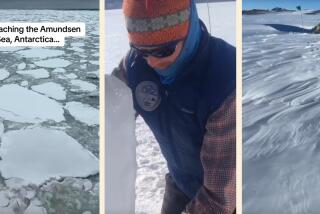Scientists are borrowing from dystopian sci-fi in a last-ditch effort to save coral reefs

- Share via
The Great Barrier Reef is bleached and dying. Because oceans are heating so quickly, nearly all of the world’s corals are projected to be dead by 2050.
Now, however, a handful of entrepreneurial scientists, many of whom have spent their careers studying the reefs that are dying before their eyes, are devising extreme measures to try to save them.
For the record:
12:40 p.m. June 26, 2019This article incorrectly refers to symbiotic single-cell organisms living in coral tissue as bacteria. They are algae. Also, corals do not make shells as the article stated. They make limestone skeletons.
Many of the solutions seem as if they’re ripped from some dystopian, science fiction novel. There are teams trying to brighten clouds so they reflect more sunlight back to space, others who want to apply floating sunscreen to acres of ocean surface. There are robots programmed to hunt and kill coral predators and groups scouring the globe for “supercorals” or attempting to breed them.
The dedication of these coral experts attempting scientific Hail Marys to save their reefs is inspiring, their technological savvy heroic. But it’s also heartbreaking to realize we’ve fouled our planet so badly by polluting and warming our oceans that we now must resort to almost fantastical measures to save our reefs. And some of the proposed solutions have raised worries about unintended consequences.
Coral scientists, fueled by money from Google, the late Paul Allen and the Australian government, are trying whatever they can.
For decades, the world’s coral reefs have been subject to all manner of assault including overfishing, pollution and habitat destruction. But the main enemy of these massive colonies of tiny marine invertebrates is global warming.
Even a temperature rise of a few degrees, as the Great Barrier Reef has seen during marine heat waves in recent years, can cause bleaching, in which corals expel the symbiotic bacteria that live inside them and feed them. The increasing acidity caused by excess carbon dioxide absorbed by the ocean makes it hard for corals to build their shells. Sea level rise and stronger storms damage reefs as well. The outlook is bleak.
So coral scientists, fueled by money from Google, the late Paul Allen and the Australian government, are trying whatever they can.
One plan calls for using cannons to shoot nanodroplets of salt into clouds to brighten them so they reflect more sunlight back into space. Another project involves pumping layers of polymer film, far thinner than a human hair, over ocean waters to act as floating sunscreen. There are proposals to pump cold water up from the ocean depths to lower the temperature of shallow coral lagoons, cover reefs with massive floating shade structures and even pulse sickly reefs with electrical currents to speed their growth.
One scientist has developed a “Ranger-bot” that could autonomously roam reefs, launching torpedoes armed with bile salts to kill the venomous crown-of-thorns starfish that relentlessly chew their way through reefs and have become more voracious in the acidified waters of our warming world. Others want to spray reefs with antibiotics or bacteria-gobbling viruses to prevent disease. Wellness cures that seem inspired by pricey spa menus are abundant as well: There are suggestions for antioxidant and nutritional supplements for coral, and of course, researchers are tinkering with the coral microbiome.
Some teams are scouring the globe looking for “super corals” that have evolved to grow happily in naturally hotter areas such as volcanic vents, coastal mangroves, even the Persian Gulf, to see if the animals can still thrive if relocated to areas where other corals have died.
And then there’s a kind of “coral IVF,” mixing coral sperm and eggs in the lab to assist reproduction. The offspring are sometimes grown directly onto small clips for easy reintegration back onto reefs or placed on giant offshore plastic “trees” made of PVC pipe to grow up.
Enter the Fray: First takes on the news of the minute »
Many of the scientists working on these imaginative remedies admit the ideas seem crazy. In fact, some of those involved with the coral rescue projects today described them as “silly,” “ridiculous” or “out there” just a few years ago. But coral reefs are collapsing so fast that many scientists have shifted into extreme rescue mode.
The work on remedies is moving quickly, too, which has caused some alarm. In Australia, environmental lawyers are waving their arms trying to get project leaders to think about regulation, environmental impact and community buy-in before projects progress further. Because many of the plans, like brightening clouds or dosing reefs with antibiotics, could have global implications, the National Academies of Sciences, Engineering, and Medicine has also gotten involved, releasing two reports in quick succession on how such work should proceed.
Coral reefs — great, silent underwater ecosystems — are wellsprings of marine life, protectors of coastlines and anchors of a vast, global food chain. And they are on the front lines as our planet warms. Coral scientists were among the first to warn us that global warming was radically harming our seas and to call for curbing our ravenous appetite for fossil fuels. But it seems we weren’t listening. Now, they are once again in the vanguard, plotting out revolutionary measures — many of which could backfire in unexpected ways — to save our reefs, our planet and ourselves.
Usha Lee McFarling, a former science writer at The Times, was co-winner of a Pulitzer Prize for explanatory journalism in 2007, for a series of articles about the crisis facing the world’s oceans.
More to Read
A cure for the common opinion
Get thought-provoking perspectives with our weekly newsletter.
You may occasionally receive promotional content from the Los Angeles Times.






